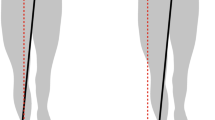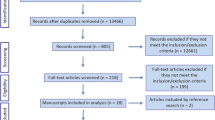Abstract
The experiment investigates the effect of ball velocity and walking direction on the adherence to the bearing angle (BA) strategy in adults. Adult participants (N=12) approached a moving ball in order to manually intercept it at a predefined target area. Results revealed that during locomotion the BA strategy was implemented, but on reaching the point of interception, this strategy broke down and the BA strategy of the wrist compensated for the movement requirements relative to the ball velocity and approach angle. Larger deviations from the BA occurred when the angle of approach was decreased and when the ball velocity increased. When the BA strategy was adhered to, postural adjustments were reduced. Increased movements occurred in a proximal–distal direction with an increasing approach angle and a faster ball velocity.



Similar content being viewed by others
References
Caljouw SR, van der Kamp J, Savelsbergh GJP (2004) Catching optical information for the regulation of timing. Exp Brain Res 155:427–438
Chardenon A, Montagne G, Laurent M, Bootsma RJ (2004) The perceptual control of goal-directed locomotion: a common control architecture for interception and navigation. Exp Brain Res 158:100–108
Chardenon A, Montagne G, Laurent M, Bootsma RJ (2005) A robust solution for dealing with environmental changes in intercepting moving balls. J Motor Behav 37:52–64
Davids K, Bennett SJ, Kingsbury D, Jolley L, Brain T (2000) Effects of posture on children’s catching performance. Res Q Exerc Sport 71:69–73
Dubrowski A, Carnahan H (2001) Control strategies when intercepting slowly moving targets. J Motor Behav 33:37–48
Laurent M, Montagne G, Savelsbergh GJP (1994) The control and coordination of one handed catching: the effect of temporal constraints. Exp Brain Res 101:314–322
Laurent M, Montagne G, Durey A (1996) Binocular invariants in interceptive tasks: a directed perception approach. Perception 25:1437–1450
Le Brun D (2002) Nouveau manuel du marin. Solar, France
Lenoir M, Musch E, Janssens M, Theiry E, Uyttenhove J (1999) Intercepting moving objects during self-motion. J Motor Behav 31:55–67
Lenoir M, Musch E, Theiry E, Savelsbergh GJP (2002) Rate of change of angular bearing as the relevant property in a horizontal interception task during locomotion. J Motor Behav 34:385–401
Montagne G, Laurent M, Durey A, Bootsma R (1999) Movement reversals in ball catching. Exp Brain Res 129:87–92
Peper L, Bootsma RJ, Mestre DR, Bakker FC (1994) Catching balls: how to get the hand to the right place at the right time. J Exp Psychol 20:591–612
Savelsbergh GJP, Bennett SJ, Angelakopoulos GT, Davids K (2005) Perceptual-motor organisation of children’s catching behaviour under different postural constraints. Neurosci Lett 373:153–158
Sparrow WA, Irizarry-Lopez VM (1987) Mechanical efficiency and metabolic cost as measures of learning a novel gross motor task. J Motor Behav 19:240–264
Steenbergen B, Marteniuk RG, Kalbfleisch LE (1995) Achieving coordination in prehension: joint freezing and postural contributions. J Motor Behav 27:333–348
Verheul MHG, Ricken AXC, Savelsbergh GJP (2003) Development of the perception–action coupling. In: Proceedings of progress in motor control IV: motor control and learning over the Life Span, Caen
Vereijken B, van Emmerik REA, Whiting HT, Newell KM (1992) Free(z)ing degrees of freedom in skill acquisition. J Motor Behav 24:133–142
Author information
Authors and Affiliations
Corresponding author
Additional information
An erratum to this article can be found at http://dx.doi.org/10.1007/s00221-005-0330-5
Rights and permissions
About this article
Cite this article
Chohan, A., Savelsbergh, G.J.P., van Kampen, P. et al. Postural adjustments and bearing angle use in interceptive actions. Exp Brain Res 171, 47–55 (2006). https://doi.org/10.1007/s00221-005-0239-z
Received:
Accepted:
Published:
Issue Date:
DOI: https://doi.org/10.1007/s00221-005-0239-z




